
CoinWeek Ancient Coin Series by Mike Markowitz ….
Ancient coins are like puppies in one respect: a good pedigree enhances their market value. For an ancient coin, “pedigree” is not a matter of bloodlines, but rather what famous collections it might have belonged to in the past. A numismatist’s heart beats a little faster at the sight of notations like “ex-Sir Arthur Evans collection ,” or “ex-Nelson Bunker Hunt collection.”
In our time, many individuals of great personal wealth prefer to keep a low profile. The identity of some of the greatest collectors is often a closely held secret. When these collections come to market, they appear under whimsical code names like “Sunrise Collection ” or “Prospero Collection .”
The Tyrant Collection is billed as “The World’s Most Valuable Coin Collection.” It will be rolled out to the public in handsomely staged displays at major coin shows over the course of several years.
“Tyrants have been the primary shapers of history for thousands of years. One of the first things tyrants do upon obtaining power is strike coins with their name and likeness, announcing their claim to their territory… Everyday coinage is the primary means by which tyrants notify their subjects and rivals of their tyranny,” the collector said.
“Coins still exist for nearly every tyrant of the last two thousand years who ever ruled a substantial country for more than a few weeks. The objective of The Tyrant Collection is to obtain a coin of every tyrant who ruled every major territory or country, preferably a large gold coin boldly displaying the tyrant’s name, likeness and titles,” he added.
This collector is evidently a person of immense wealth and exquisite taste, advised by top numismatic experts. The collection consists of parts grouped by geographic area. “Tyrants of the Thames,” covering Britain, was exhibited last year . “Tyrants of the Tigris and Euphrates” covering the Middle East appeared this year at the Long Beach, California coin show . In future years we will see ancient Egyptian (“Tyrants of the Nile”) Greek (“Tyrants of the Aegean,”) Roman (“Tyrants of the Tiber,”) French (“Tyrants of the Seine”) and other parts.
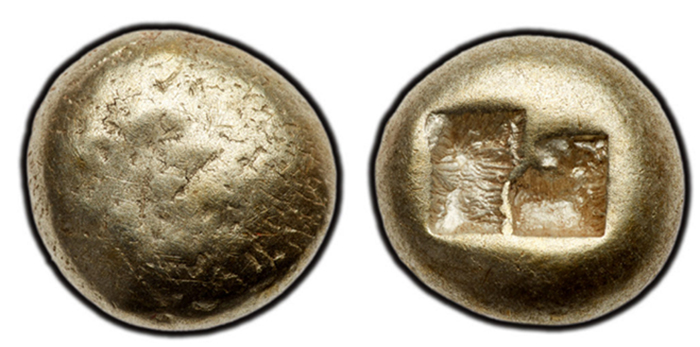
“Tyrants of the Tigris and Euphrates” includes 357 coins, arranged in chronological order. The earliest pieces (c. 650 – 600 BCE) from the dawn of Western coinage are lumpy electrum globules from uncertain mints in Ionia, with no designs and deep punch marks.

There are two examples of the earliest coin to bear an inscription, an electrum stater of Ephesos that proclaims “I am the badge of Phanes,” in Greek above a grazing stag, c. 625 -600 BCE. We don’t know whether Phanes was a ruler, a merchant, or an official. This coin is #61 on Harlan Berk’s list of the 100 greatest ancient coins , and he notes that only three examples of the stater, and a few one-third staters are known.
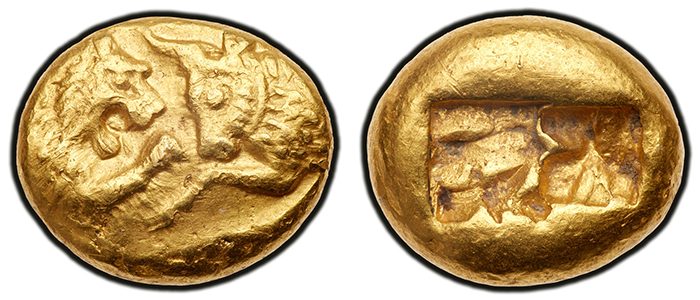
By the sixth century, advances in metallurgy made it possible to refine nearly pure gold and silver from ores in which these precious metals are mixed. Kroisos (better known under the spelling “Croesus ,”) king of Lydia (c. 560 – 546 BCE) issued the first “bimetallic” coinage of gold and silver staters and a range of fractions. The Tyrant Collection includes 15 of these coins (seven gold and eight silver) including two of the 11 known gold staters. On Berk’s list of the 100 greatest ancients, this coinage is #9 .
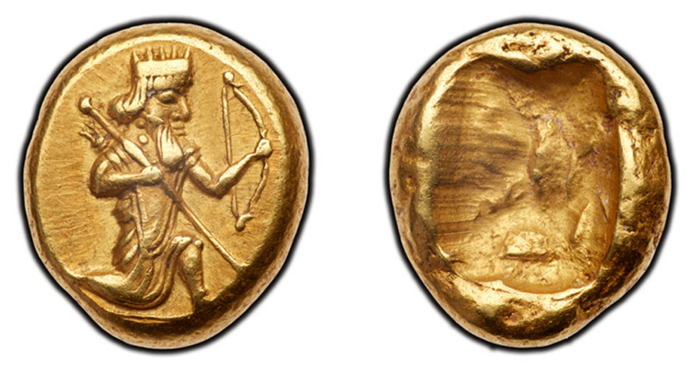
The gold daric of Persia is one of the few coins mentioned in the Old Testament. It depicts the king holding a bow in one hand and a spear (rarely a dagger) in the other. Ancient Greeks called these coins “archers.” There is no inscription, and the reverse is just a punch mark, but the dating of the series was worked out by British numismatist, Ian Carradice . The Tyrant Collection includes six of these coins ranging from extremely fine to mint state.

One of most beautiful and historic coins in the collection (in this writer’s opinion) is a rare mint state anonymous gold stater of Pergamum, struck c. 334-332 BCE. The obverse shows the head of Herakles wearing the lion skin. The reverse is a standing image of the goddess Athena. In recent auctions, examples have sold for $50,000 – $100,000. In the words of one cataloger:
The most recent analysis of known specimens by François de Callataÿ, published in 2012, identified five obverse and seven reverse dies, perhaps produced by two different engravers…. He suggests the coins were personally commissioned by Alexander shortly after his initial invasion of Asia Minor and seizure of Pergamum in 334 BC, utilizing dies produced by engravers accompanying his army. The lack of an identifying ethnic and the different imagery than that employed on Alexander’s usual gold staters could be explained by the desire to maintain “deniability” should the fortunes of war shift and the Persians regain the city. These staters, then, are the first coins produced at what would go on to become one of antiquity’s greatest cities and the capital of its own empire in the Hellenistic era.
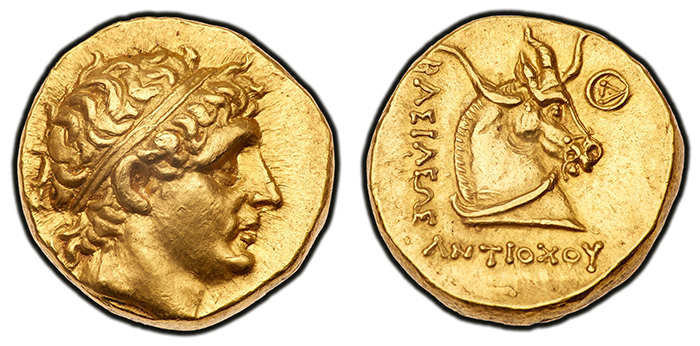
The Seleucid dynasty ruled one of the states that emerged from the breakup of Alexander’s empire. The term “exceedingly rare” is often thrown around casually in classical numismatics, but the gold stater of Antiochos I is one of the great rarities in this collection. Struck at the remote outpost of Ai Khanoum in what is now Afghanistan c. 280 – 261 BCE this piece bears a handsome portrait of the king in fine Hellenistic style. The reverse shows a horse head with ornamental horns. It was once thought that this horse was Bucephalus, legendary steed of Alexander the Great. It is now considered to be the horse that carried Seleucus, father of Antiochos, from Babylon to refuge in Egypt in 315 BCE. In a 2017 European auction, the only other example of this type (not quite as good) to appear on the market recently sold for over US$108,000 .
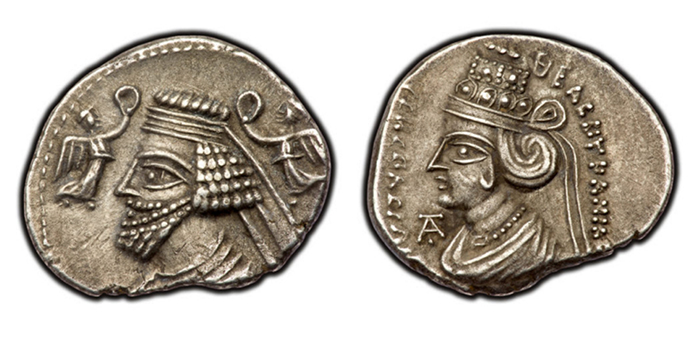
The collection includes more than 80 Parthian coins, many in mint state or “superb extremely fine” condition. One of the most interesting is the silver drachm of king Phraatakes and Queen Musa. Roman emperor Augustus sent Parthian king Phraates IV an Italian slave girl named Musa as a diplomatic gift. She bore the king a son. In 2 BCE she poisoned the king and ruled as regent for her young son, Phraatakes, shocking the Parthians by marrying him. On her rare coins, (inscribed “Heavenly Goddess, Queen Musa”) she wears an elaborate tiara that looks rather like a modern wedding cake. The incestuous couple were overthrown and killed about 5 CE.

The Sasanian Empire ruled Persia for over four centuries, much of the time at war with Rome, or with invading nomadic central Asian tribes. The Tyrant Collection includes over 60 Sasanian coins, including many exceedingly rare gold pieces, such as the dinar of the dynasty’s founder, Ardashir I (c 233 – 239 CE) from the mint of Hamadan in northwest Iran.
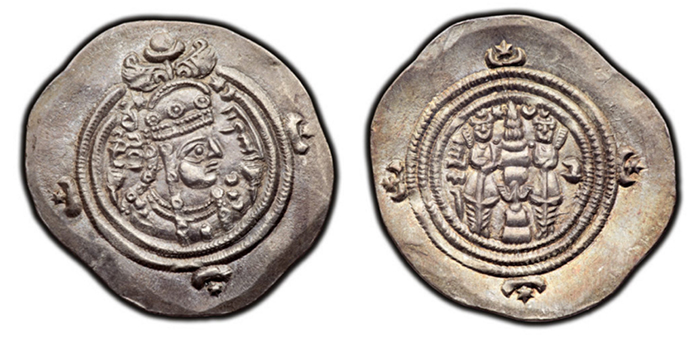
One of the great Sasanian rarities in the colection is the silver drachm of Boran (or Puran) crowned in 630 CE as the first ruling queen in the empire’s long history, when there were no eligible surviving male heirs. The sources on her reign are scant and contradictory; by some accounts she ruled with wisdom and justice for two years, others suggest she was a powerless figurehead for six months. She either died of illness, or was murdered.
On the coinage her portrait is recognizable by the absence of a beard.
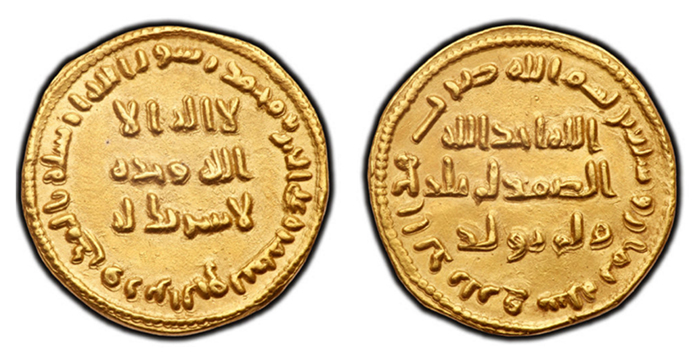
The collection includes over 120 Islamic coins from various dynasties and mints. Particularly notable is a mint state gold dinar of the Umayyad caliph ‘Abd al-Malik (685 – 705 CE) struck at Damascus in Year 77 of the Muslim era (696 – 697). This was the first coin to have inscriptions in Arabic calligraphy as the only obverse and reverse designs. Surprisingly absent from the collection is the rare “Standing Caliph” dinar that preceded it .
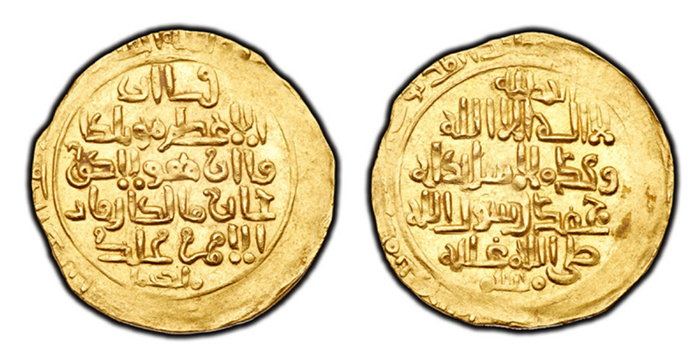
In 1258, invading Mongols sacked Baghdad – the brilliant capital of the Abbasid dynasty. The last Abbasid caliph, al-Musta’sim was rolled in carpets and trampled to death, because Mongols considered it bad luck to shed royal blood on the ground. As with Chinggis Khan’s conquest of China, the invaders gradually adapted to the culture and customs of their subjects. A dynasty of Mongols, the Ilkhans ruled in the region until 1353. Hulagu, a grandson of Chinggis, was the first Ilkhan ruler, and his gold dinar of Baghdad is one of the highlights of the collection.
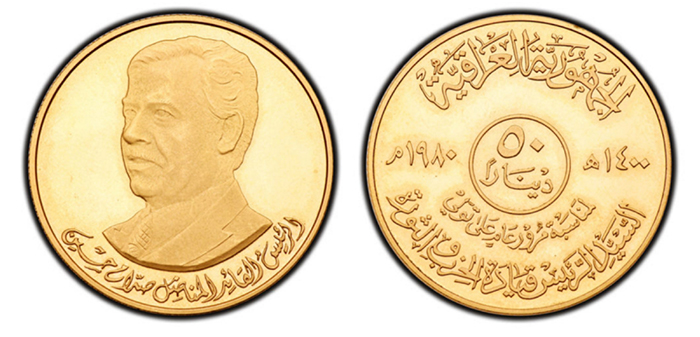
The Tyrant Collection ends with modern coins of the Kingdom (1921 – 1958) and Republic (since 1958) of Iraq. The last item is a gold 50 dinar piece of Saddam Hussein, who surely deserved the title of Tyrant, commemorating his first year as president.
Handsomely presented in museum-quality display cases, the coins are accompanied by detailed labels providing the full “attribution” (numismatic description and references) and historical context of each item. Since only the portrait side of the coin is visible (for coins that bear portraits) there are enlarged color photos of the obverse and reverse, allowing viewers to appreciate the details.
A full-color “pocket guide” (distributed free at the show) depicts 89 highlights of the collection. The softcover 164-page full catalog was sold for $10.
Although the identity of the collector is a closely guarded secret, Ira Goldberg, John Dannreuther and Yifu Che are credited as consultants, and numismatists David Tranbarger, John Lavender and Bahram Badiyi are listed as catalogers.
References
Berk, Harlan J. 100 Greatest Ancient Coins. Atlanta (2008)
I. Carradice, “The ‘Regal’ Coinage of the Persian Empire,” in I. Carradice, ed., Coinage and Administration in the Athenian and Persian Empires. Oxford (1987)
Linzalone, Joseph. Electrum and the Invention of Coinage. (2011)
Sotheby’s. The Nelson Bunker Hunt Collection: Highly Important Greek and Roman Coins. New York (1990)




